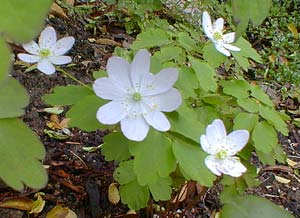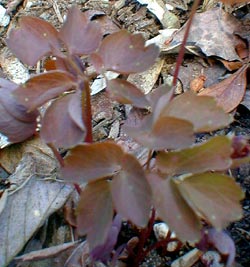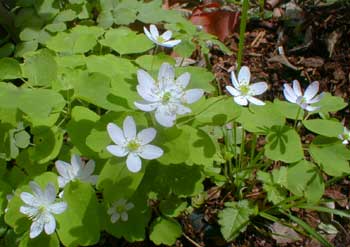
Rue Anemone; aka,
Anemonella
"How many Flowers fail in Wood --
Or perish from the Hill --
Without the privilege to know
That they are Beautiful."
-Emily Dickinson
1830‚1886
1830‚1886
The species name of Anemonella thalictroides (formerly Syndesmon thalictroides & Thalictrum anemonoides) alludes to this plant's leaves "like meadow rue," while its genus name "little windflower" refers to the blooms as looking like miniature anemones.
 In the shade of a paperbark maple, this charming wee plant puts up only few leaves by earliest April, when it already cannot help itself, it has to produce a flower or two even before it has much bushed out. The photo up top is its very first flower of spring. The second flower nearer April's end shows the tiny clump coming along splendidly, with paler leaves & increasing numbers of flowers.
In the shade of a paperbark maple, this charming wee plant puts up only few leaves by earliest April, when it already cannot help itself, it has to produce a flower or two even before it has much bushed out. The photo up top is its very first flower of spring. The second flower nearer April's end shows the tiny clump coming along splendidly, with paler leaves & increasing numbers of flowers.At any given moment the little plant is not terribly floriferous, as it sometimes seems as though buds are waiting to open one to five at a time, but never a great many all at once. It makes up for this reticence by blooming continously through spring.
Flowers of rue anemone range from white to lilac-pink; but ours is such a faint shade of lilac it is nearly white, & ranging more toward a hint of blue rather than pink. The usual yellow anthers are in this case yellow-green.
Reddish stems arise from the tuberous root in late March, as shown in the second photo. The leaves emerge purple but quickly turn purplish green, & are joined by the flowers immediately in April, lasting well into June.
 As it matures into a six inch by six inch clump (occasionally to nine inches), the foliage turns increasingly lime green, but for the first week or so of blossoms, the flowers drift just above purplish-green foliage.
As it matures into a six inch by six inch clump (occasionally to nine inches), the foliage turns increasingly lime green, but for the first week or so of blossoms, the flowers drift just above purplish-green foliage.An effective bright-shade plant for chilly & temperate zones, this Great Lakes, midwest & southeast native wildflower asks for moist well-draining humousy soil.
It can seem to be drought tolerant at times, but it will really only bloom well if kept moist. It naturally dies back in summer, & will do so more quickly if dryness triggers its sense that summer's upon it. Before it dies back it develops endearing ribbed seedpods arranged like petals.
Growing nearby are equally little Anemone nemorosa "Robinsoniana" & A. nemorosa "Vestal" wood anemones. These are similarly long-flowering but die back in summer.
These tiny plants are collectively overshadowed by a bushing Fuchsia magellanica var molinae which either dies back in winter or gets so scruffy during winter that whatever remains of it needs to be severely cut back in order to start over. It regains its looks by mid-spring, so for a while the wood anemones & rue anemone dominate this small edge of the garden. Well before the anemones are vanishing in summer, the fuchsia is again in fine form, & keeps the same spot geen & flowery late spring, summer, & well into autumn.
Even though anemonella may well be toxic, people of the first nations made a tea from the roots as a remedy for diarrhea & digestion problems.